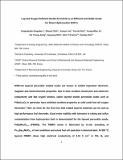Layered oxygen-deficient double perovskite as an efficient and stable anode for direct hydrocarbon solid oxide fuel cells
Date
02/2015Author
Grant ID
EP/I022570/1
WRMA 2012/R2
EP/K015540/1
EP/I022570/1
Metadata
Show full item recordAbstract
Different layered perovskite-related oxides are known to exhibit important electronic, magnetic and electrochemical properties. Owing to their excellent mixed-ionic and electronic conductivity and fast oxygen kinetics, cation layered double perovskite oxides such as PrBaCo2O5 in particular have exhibited excellent properties as solid oxide fuel cell oxygen electrodes1. Here, we show for the first time that related layered materials can be used as high-performance fuel electrodes. Good redox stability with tolerance to coking and sulphur contamination from hydrocarbon fuels is demonstrated for the layered perovskite anode PrBaMn2O5+δ (PBMO). The PBMO anode is fabricated by in situ annealing of Pr0.5Ba0.5MnO3−δ in fuel conditions and actual fuel cell operation is demonstrated. At 800 °C, layered PBMO shows high electrical conductivity of 8.16 S cm−1 in 5% H2 and demonstrates peak power densities of 1.7 and 1.3 W cm−2 at 850 °C using humidified hydrogen and propane fuels, respectively.
Citation
Sengodan , S , Choi , S , Jun , A , Shin , T H , Ju , Y-W , Jeong , H Y , Shin , J , Irvine , J T S & Kim , G 2015 , ' Layered oxygen-deficient double perovskite as an efficient and stable anode for direct hydrocarbon solid oxide fuel cells ' , Nature Materials , vol. 14 , no. 2 , pp. 205-206 . https://doi.org/10.1038/nmat4166
Publication
Nature Materials
Status
Peer reviewed
ISSN
1476-1122Type
Journal article
Description
This research was supported by the New & Renewable Energy of the Korea Institute of Energy Technology Evaluation and Planning (KETEP) (20113020030060) grant by the Korea government Ministry of Trade, Industry and Energy, the (2013R1A2A2A04015706) through the National Research Foundation of Korea, funded by the Ministry of Science, ICT and Future Planning and the Basic Science Research Program (2013R1A2A2A01007170 and 2010-0021214) through the National Research Foundation of Korea funded by Ministry of Education. We thank The Royal Society for a Wolfson Merit Award (JI) and EPSRC for a research grant (EP/I022570/1).Collections
Items in the St Andrews Research Repository are protected by copyright, with all rights reserved, unless otherwise indicated.

